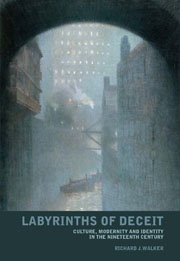Book contents
- Frontmatter
- Contents
- Acknowledgements
- Introduction: Tracing the fragments of modernity
- Part I (De)Generating doubles: duality and the split personality in the prose writing of James Hogg, Robert Louis Stevenson and Oscar Wilde
- Part II The stripping of the halo: religion and identity in the poetry of Alfred Tennyson, James ‘B. V.’ Thomson and Gerard Manley Hopkins
- Introduction
- 4 A life of death: Alfred Tennyson's ‘St Simeon Stylites’
- 5 But what am I? Alfred Tennyson's In Memoriam
- 6 All is vanity and nothingness: James ‘B. V.’ Thomson's haunted city
- 7 Dead letters: Gerard Manley Hopkins's ‘Terrible Sonnets’
- Part III Infected ecstasy: addiction and modernity in the work of Thomas De Quincey, Alfred Tennyson, Christina Rossetti and Bram Stoker
- Conclusion: Ghost-script
- Notes
- Bibliography
- Index
7 - Dead letters: Gerard Manley Hopkins's ‘Terrible Sonnets’
from Part II - The stripping of the halo: religion and identity in the poetry of Alfred Tennyson, James ‘B. V.’ Thomson and Gerard Manley Hopkins
- Frontmatter
- Contents
- Acknowledgements
- Introduction: Tracing the fragments of modernity
- Part I (De)Generating doubles: duality and the split personality in the prose writing of James Hogg, Robert Louis Stevenson and Oscar Wilde
- Part II The stripping of the halo: religion and identity in the poetry of Alfred Tennyson, James ‘B. V.’ Thomson and Gerard Manley Hopkins
- Introduction
- 4 A life of death: Alfred Tennyson's ‘St Simeon Stylites’
- 5 But what am I? Alfred Tennyson's In Memoriam
- 6 All is vanity and nothingness: James ‘B. V.’ Thomson's haunted city
- 7 Dead letters: Gerard Manley Hopkins's ‘Terrible Sonnets’
- Part III Infected ecstasy: addiction and modernity in the work of Thomas De Quincey, Alfred Tennyson, Christina Rossetti and Bram Stoker
- Conclusion: Ghost-script
- Notes
- Bibliography
- Index
Summary
I shall shortly have some sonnets to send to you, five or more. Four of these came like inspirations unbidden and against my will. And in the life I lead now which is one of a continually jaded and harassed mind, if in any leisure I try to do anything I make no way – nor with my work alas! but so it must be.
Tennyson's dramatic monologue, ‘St Simeon Stylites’, implies an identifiable audience to whom the eponymous anchorite periodically appeals; in Simeon's case the dramatically involved but emphatically silent addressee for the monologist can be defined at various stages as the divine (God) or human (the crowd that flocks at the base of the pillar). In each case the silence of the audience has a dramatic logic: God's silence is symptomatic of the division between natural and supernatural and of the traditional inscrutability of the divine, whereas the audience's is the result of the more conventional distancing device of height, Simeon's physical elevation on his pillar prohibits communicative interaction with the crowd. However, poetically what remains is the ‘dialogue of the mind with itself’ voicing the ‘doubts’ and ‘discouragement’ discussed by Matthew Arnold. The result is a colloquy that is defined by Roger Platizky as ‘the tension between individual trust and social expectations’ and in the ‘psychological dynamic between the nonconforming self (the hypervigilant, mad speaker) and … the silent auditor[s]’ to whom it speaks.
- Type
- Chapter
- Information
- Labyrinths of DeceitCulture, Modernity and Identity in the Nineteenth Century, pp. 175 - 190Publisher: Liverpool University PressPrint publication year: 2008

